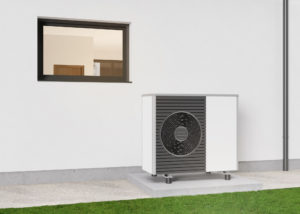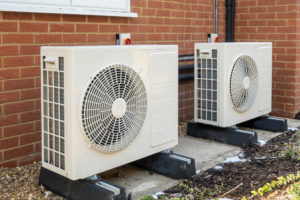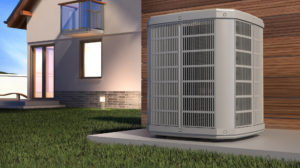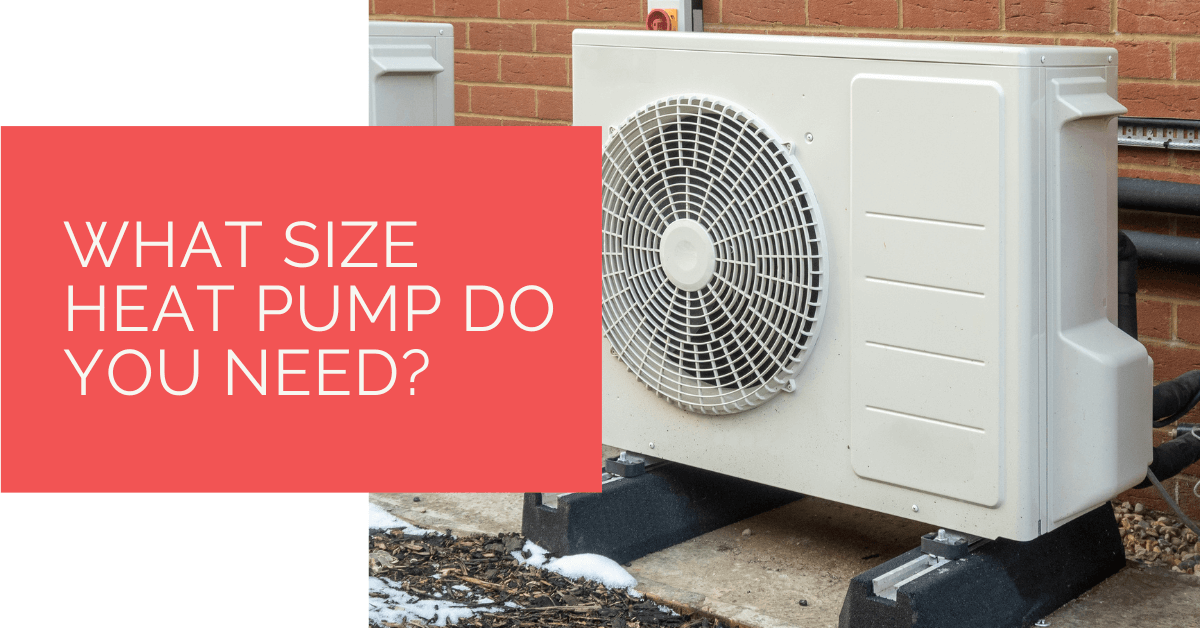Heat pump systems might be one of the hottest topics in the market right now, given their ability to act as energy-efficient alternatives. This heating system ensures that your room stays cool during summers and allows warm air inside your space during harsh winters. Not only do they take up less space, but they also maintain air temperatures in your house.
They are available in numerous sizes, depending on the type of heat pump you require and the associated units. It also depends on the size of your space. If you invest in a smaller system, your house might not receive the advertised benefits. On the other hand, massive heat pumps may result in excess heat, inviting discomfort to your space.
Read ahead to understand the sizes available better and find the best heat pump for your home!
Contents
Key Takeaways
- Heat pumps come in various sizes, and choosing the right size is crucial for optimal performance. Smaller systems may not provide sufficient heating or cooling, while larger ones can lead to discomfort and excess heat in your space.
- Determining your home’s appropriate heat pump size involves factors like the square footage, climate, insulation quality, and more. The Manual J method and a blower door test can help calculate the right size accurately.
- Mis-sizing your heat pump can lead to uneven temperature, moisture buildup, increased energy costs, and maintenance expenses. To ensure the best results, consider consulting professionals and choosing an MCS-accredited heat pump.
Components of a Heat Pump System
Heat pump systems enable the transfer of heat from one place to another. They achieve this function with the help of some components, namely:
- Indoor Unit
- Outdoor Unit
- Refrigerant
- Compressor
- Reversing Valve
- Expansion Valve
The indoor and outdoor units form the primary system. Indoor systems are usually found indoors, affixed to walls with a hole drilled near them to establish a link with the outdoor unit. The outdoor unit is the heart of the system and is usually installed above the ground to trap outside air (in the case of air source pumps) or water (for water-source pumps).
The refrigerant absorbs and rejects heat, while the compressor allows the air or water to move throughout the system. Reversing valve allows the system to alternate between heating and cooling, and the expansion valve regulates the flow of the hot or cool air obtained from the refrigerant.
When choosing a heat pump system for your home, the size of the indoor and outdoor units is taken into account.

Heat Pump Sizes in the Market
There is no better time than now to consider investing in a heat pump for your home. Various incentives and initiatives, such as those aimed at promoting renewable heating options, have been introduced to encourage heat pump installations. To choose the most suitable pump for your needs, it’s essential to understand the available sizes and options in the market.
Finding your house’s ideal heat pump sizing may involve extensive calculations and professional consultations. However, some standard sizes available in the market may come in handy when choosing a heat pump system. Some of the common heat pump sizes, along with the corresponding home sizes, are given below.
| Home size (in square feet) | Heat pump size (tons) | Heat pump size (BTU) |
| 500 | 1 | 12,000 |
| 1000 | 2 | 24,000 |
| 1500 | 3 | 36,000 |
| 2000 | 4 | 48,000 |
| 2500 | 5 | 60,000 |
The sizes follow the same trends as they increase, with a one-ton increase for over 500 square feet of space added. However, all homes may not fall in the sizes provided below. So, how do you calculate the pump size for your home?
Measuring Heat Pump Sizes for Your Space
Numerous methods can yield the ideal heat pump system size for your house. These are tried and tested and may require professional assistance to perform. However, an industry-standard test often helps in determining the size of heat pumps.
Manual J Method
All industries have a standard method of performing processes or fixed standards that must be followed while performing the procedures. In a similar fashion, Manual J is the industry standard for sizing a heat pump. It is a system established by the Air Conditioning Contractors of America and follows eight factors to find the right size. These are:
- An estimation of the local climate to determine how frequently you might need the heating and cooling functions of the pump
- The square footage of your home and the configuration/layout of the space
- The number of windows and their location
- The air filtration system in your home
- Insulation quality in your space
- The number of people residing in their house and how many people require heating or cooling at once
- Your ideal temperature
- The number and types of heat-generating appliances in your home
The list of questions might seem extensive, but each is important to finding the right heat pumping system for your home. Smaller or bigger sizes may lead to fluctuating or extreme temperatures in the house.

Blower Door Tests
People use the Manual J method along with a blower door test to produce reliable results. This method is used for detecting the amount of air that enters or leaves your house. It also helps in detecting heat loss.
Based on the test results, you can identify the areas of air leakage in your house and remedy them. Not only will this help save energy, but it will also allow your room to maintain the intended temperature.
The procedure of the test is straightforward—the professional mounts the blower door, a powerful fan, on the exterior doorway of your house. After calibration, the fan sucks the air out of the house, creating a low-pressure area inside. The outside air may flow into the low-pressure area if there are cracks or gaps.
Along with the blower test, the professional may use an infrared camera to check for hidden gaps and determine areas where insulation is missing. Ultimately, blower door tests help gauge the energy consumption of your house, which you can measure against the parameters of the Manual J method to confirm the size of heat pumps for your home.

Problems with Oversized or Undersized Heat Pumps
Now, you might think, it is okay if the pumps produce too much heat or lesser heat, right? The difference would probably not be evident. Unfortunately, that is not the case.
An undersized heat pump will make you feel colder during winters and warmer during summers since it doesn’t cover the entire house. You might have to shift to the space covered by the heat pump, which might not be comfortable.
On the other hand, an oversized unit will trigger on and off constantly and enable moisture to build up in your home. Oversized heat pumps usually run on variable speed motors. Following this principle, they adjust the amount of heating or cooling according to the temperature outside.
Since appropriately-sized heat pumps pull moisture from the air and prevent mould build-up, any compromise in size will invite significant problems. Your home will also have a fluctuating temperature due to the system constantly turning off and on.
These heat pumps will also pose problems according to the temperature of your region. For example, people in humid areas also use heat pumps as dehumidifiers. If it constantly turns on and off, the resultant moisture may build up to an uncomfortable amount. Similarly, people in dry climates will experience hot and cold spots throughout the house since the heat pump will constantly turn off and on.
Not to mention, purchasing the wrong size for your home may add to costs since the heat pump may draw more electricity and in turn, increase the power bill. It might also cause wear and tear in your heating pump system, leading to a shorter life and more maintenance costs to ensure it is working as intended.
Heat Pump Source: Reliable Heating and Cooling Solutions
At Heat Pump Source, we take pride in our unwavering commitment to serving the UK with top-tier HVAC solutions. From the efficiency of heat pumps and the cool relief of air conditioning to the warmth of boilers, radiators, and underfloor heating, our dedicated team is always at the forefront of innovation. We understand the unique needs of every household and business, and we strive to provide dependable health and cooling products and services that are tailored just for you. Ensuring your comfort and satisfaction is our utmost priority. Whether you have questions, need guidance, or require support, we’re always here to assist. Please don’t hesitate to contact us; we’re eager to be of service.
Final Thoughts
Different manufacturers have different sizes for heat pumps. It is essential to purchase an MCS-accredited heat pump to ensure it delivers on quality. You can also consult a professional to perform a blower door test and use the results to determine the size of heat pumps perfect for your house.
In the end, your efforts will be rewarded with the presence of an ideal heat pump, ensuring comfort irrespective of the season. It will also save your power bills and provide unmatched energy efficiency in the long run.
Consult a professional or engage in market research and call a heat pump installer today!
About the Author
At Heat Pump Source, our articles are the product of a collaborative effort among a team of highly skilled HVAC experts. Our dedicated professionals, hailing from diverse backgrounds in heating, ventilation, air conditioning, and refrigeration, contribute their extensive knowledge and experience to every piece of content. This multidisciplinary approach ensures comprehensive coverage. Our commitment is to deliver authoritative, reliable, and tailored advice to meet the unique needs of every household and business across the UK.

